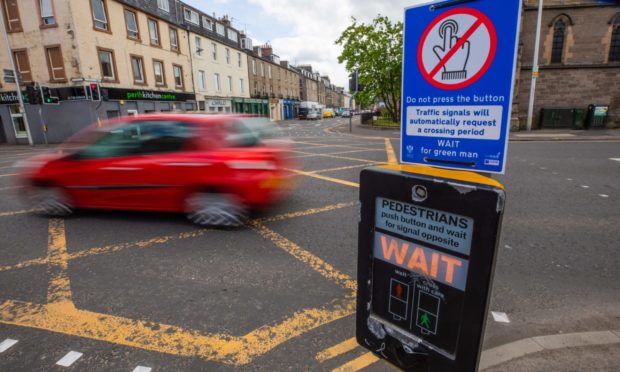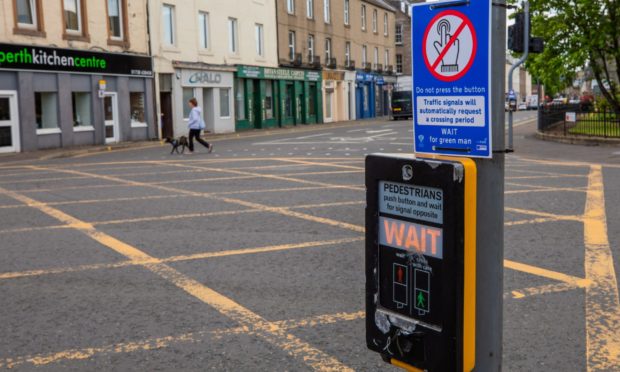Contactless pedestrian crossings are being trialled in Perth and Kinross in a bid to reduce the spread of coronavirus.
New sensors on the crossings allow people to activate the green man with no physical contact.
Users swipe their hand under the button in a move that council bosses hope will both reduce Covid-19 transmission and help people with reduced mobility.
Reduced mobility
The local authority says the new contactless pedestrian crossings – launched at eight sites – are designed to assist pedestrians with reduced mobility.
A Bluetooth button can be fitted to wheelchairs, walking canes or be carried.
These can be used to request a green man from two metres away.
Head of environmental and consumer services at Perth and Kinross Council Mark Butterworth said: “We have been looking for a solution that allows people to use pedestrian crossings without having to touch the button and risk any spread of coronavirus.
“Not only do these devices offer that protection, we also hope that they will make it much easier for people with mobility issues to use crossings and enjoy our town and city centres.”
Local groups
The move has been welcomed by local groups that support people with disabilities and reduced mobility.
VisionPK, who supports people with sensory impairments, believes some people may feel wary amid the gradual lifting of restrictions.
A spokesperson for the charity said: “As we move out of restrictions, it is likely that many people, especially individuals who are visually impaired, will feel slightly cautious moving about once familiar areas.
“Lifestyle requirements from being visually impaired could potentially increase the exposure to Covid-19 due to the need to frequently touch surfaces to identify things, help with orientation and to locate controls such as pedestrian crossings.
“VisionPK is delighted therefore that Perth and Kinross Council are trialling technologies to allow the activation of these crossings without the need to touch the control button.”
Automated crossings
The new plans come after crossings across the region were set to automatic timers in response to the pandemic.
However, council bosses agreed to ditch them less than four months after their roll-out in response to concerns raised by motorists.
The automated changes meant drivers were often forced to stop at red lights even when there were no pedestrians waiting to cross, causing congestion in some areas.
But the Centre for Inclusive Living Perth and Kinross (CILPK) says the council’s backtrack on the original plans caused disappointment among some of its members.
A spokesperson for the organisation said: “Members reported to CILPK that when the crossings were made automatic during lockdown it was much easier for them, and were disappointed when that option was taken away, though they understood the frustrations of the drivers having to stop at so many crossings.
“CILPK fully supports the work that PKC are carrying out with Smart Cross to find solutions and avoid annoyance for others and will be involved in the trials to ensure any complications are picked up from the outset.”
The trial of contactless pedestrian crossings has been rolled out at:
- North Methven and Mill Street;
- Atholl Street, Methven;
- Methven High Street;
- Caledonian Road, The Lade
- South Street, King Edward;
- Dunkeld Road, Bannatyne Place;
- Glover Street at Medical Centre, Perth; and
- Muirs, Kinross

